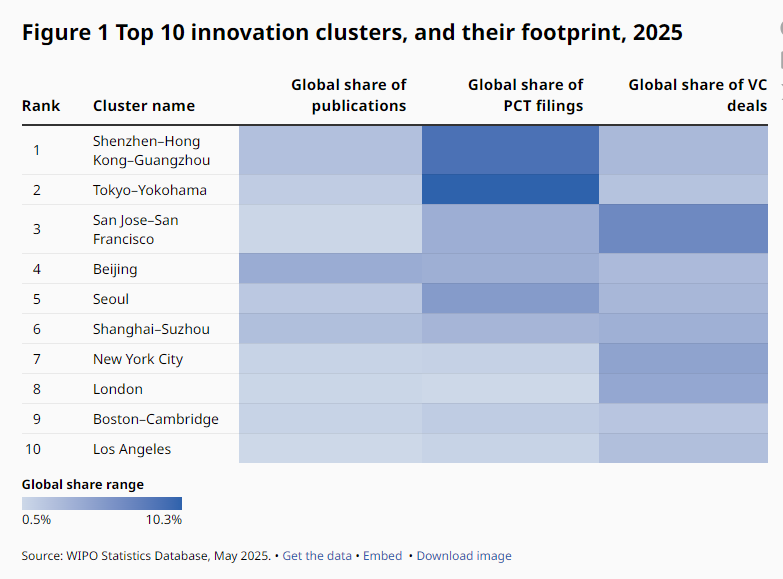SZ fuels China's first entry into Global Innovation Index top 10
Writer: | Editor: Yu Xiyao | From: | Updated: 2025-09-18
 An aerial view of Guangming, Shenzhen — one of China's most dynamic innovation zones. Liu Xudong
An aerial view of Guangming, Shenzhen — one of China's most dynamic innovation zones. Liu Xudong
China secured 10th place on the World Intellectual Property Organization's (WIPO) Global Innovation Index (GII) 2025, released the day before yesterday, marking the first time the country has appeared in the top 10. Switzerland topped the list, followed by Sweden, the U.S., South Korea, Singapore, the U.K., Finland, the Netherlands, Denmark, and China.

The top 15 countries and regions ranked in the WIPO's Global Innovation Index 2025. Source: Global Innovation Index Database, WIPO, 2025
The Shenzhen–Hong Kong–Guangzhou science and technology cluster, one of 24 Chinese clusters on the index, earned the top spot globally for the first time after placing second since 2020. For the third consecutive year, China is home to more top 100 global science and technology innovation clusters than any other country.

The Shenzhen–Hong Kong–Guangzhou science and technology cluster ranks first on WIPO's 2025 list of top innovation clusters. Source: Global Innovation Index Database, WIPO, 2025
The index evaluates the innovation performance of nearly 140 economies using approximately 80 indicators, including research and development (R&D) spending, venture capital (VC) deals, high-tech exports, and intellectual property filing.
China has maintained its lead among middle-income economies globally and shows continued strength in R&D spending, high-tech exports, and innovation outputs, according to the report.
In the rankings, 17 low- and middle-income economies have performed above expectations for their level of development, with India and Vietnam being the longest-running innovation overperformers. Sub-Saharan Africa leads in the number of economies overperforming on innovation, led by South Africa, Senegal, and Rwanda.
Southeast Asia, East Asia, and Oceania remain a driving force in global innovation in 2025, with six economies ranked among the top 25.
Beyond innovation rankings, the 2025 edition shows uneven performance in leading indicators of future innovation activity. R&D growth in 2024 fell to its lowest level since the 2010 financial crisis. Due to persistent inflation, real growth in business R&D expenditure slowed to 1%, well below the past decade's average of 4.6%.

A UBTECH humanoid robot operates on a production line. Xinhua
Information and communications technology (ICT)-related companies, AI-intensive sectors, and software and pharmaceutical firms increased R&D budgets, while manufacturing sectors such as automobiles and consumer goods have cut R&D spending amid declining revenue.
Venture capital rebounded, with transaction value growing by 7.7% in 2024, largely driven by mega-deals in the United States and a surge in generative AI investments. However, excluding these, venture capital would have contracted.
Technological progress, a dimension covered in the GII Global Innovation Tracker, remained strong, with battery prices and supercomputer efficiency improving and the cost of genome sequencing declining further.
"However, innovation isn't standing still. It's recalibrating. New breakthroughs are still reaching people around the world — from green supercomputing and artificial intelligence to smarter batteries, faster internet, and better cancer care," said WIPO.
"While we see encouraging signs of recovery in areas such as innovation uptake and impact, the global innovation engine is not firing on all cylinders. Slower growth in R&D investments and declining VC activity reminds us that innovation requires sustained upstream and financial commitment," said WIPO Director General Daren Tang during a press release.